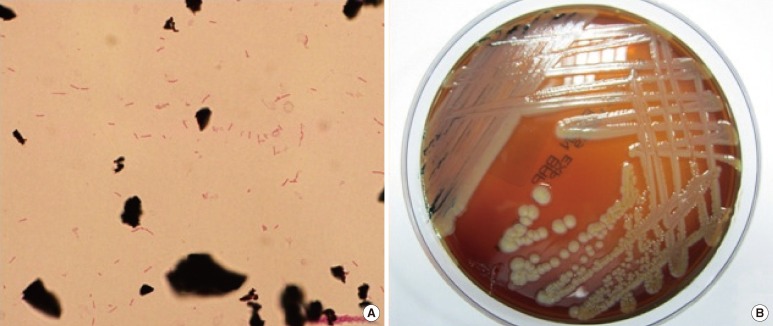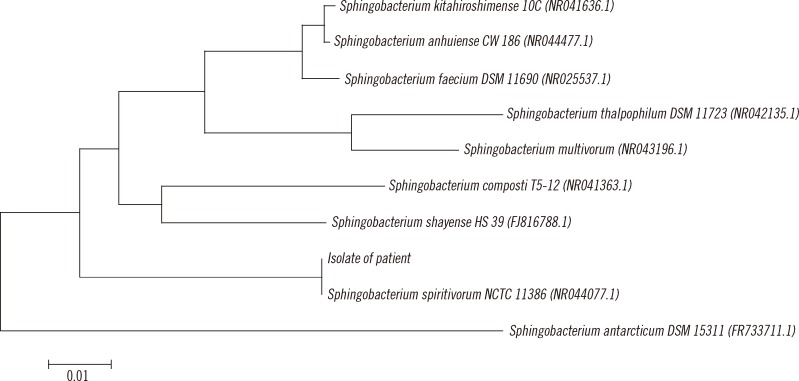Ann Lab Med.
2013 Jul;33(4):283-287. 10.3343/alm.2013.33.4.283.
The First Korean Case of Sphingobacterium spiritivorum Bacteremia in a Patient with Acute Myeloid Leukemia
- Affiliations
-
- 1Department of Laboratory Medicine, Pusan National University School of Medicine, Busan, Korea. socioliberal@yahoo.co.kr
- 2Department of Internal Medicine, Pusan National University School of Medicine, Busan, Korea.
- KMID: 1707237
- DOI: http://doi.org/10.3343/alm.2013.33.4.283
Abstract
- Sphingobacterium spiritivorum has been rarely isolated from clinical specimens of immunocompromised patients, and there have been no case reports of S. spiritivorum infection in Korea to our knowledge. We report a case of S. spiritivorum bacteremia in a 68-yr-old woman, who was diagnosed with acute myeloid leukemia and subsequently received chemotherapy. One day after chemotherapy ended, her body temperature increased to 38.3degrees C. A gram-negative bacillus was isolated in aerobic blood cultures and identified as S. spiritivorum by an automated biochemical system. A 16S rRNA sequencing analysis confirmed that the isolate was S. spiritivorum. The patient received antibiotic therapy for 11 days but died of septic shock. This is the first reported case of human S. spiritivorum infection in Korea. Although human infection is rare, S. spiritivorum can be a fatal opportunistic pathogen in immunocompromised patients.
MeSH Terms
-
Aged
Anti-Bacterial Agents/therapeutic use
Bacteremia/*complications/drug therapy/*microbiology
Bone Marrow Cells/pathology
Fatal Outcome
Female
Humans
Immunocompromised Host
Leukemia, Myeloid, Acute/*complications
Phylogeny
RNA, Ribosomal, 16S/genetics
Sequence Analysis, DNA
Shock, Septic/etiology/microbiology
Sphingobacterium/classification/genetics/isolation & purification/*physiology
Anti-Bacterial Agents
RNA, Ribosomal, 16S
Figure
Reference
-
1. Versalovic J, Carroll KC, editors. Manual of clinical microbiology. 10th ed. Washington, DC: ASM Press;2011. p. 723–727.2. Holmes B, Owen RJ, Weaver RE. Flavobacterium multivorum, a new species isolated from human clinical specimens and previously known as group IIk, biotype 2. Int J Syst Bacteriol. 1981; 31:21–34.3. Holmes B, Owen RJ, Hollis DG. Flavobacterium spiritivorum, a new species isolated from human clinical specimens. Int J Syst Bacteriol. 1982; 32:157–165.4. Yabuuchi E, Kaneko T, Yano I, Moss CW, Miyoshi N. Sphingobacterium gen. nov., Sphingobacterium spiritivorum comb. nov., Sphingobacterium multivorum comb. nov., Sphingobacterium mizutae sp. nov., and Flavobacterium indologenes sp. nov.: Glucose-nonfermenting gram-negative rods in CDC groups IIK-2 and IIb. Int J Syst Bacteriol. 1983; 33:580–598.5. Aydo an M, Yumuk Z, Dündar V, Arisoy ES. Sphingobacterium multivorum septicemia in an infant: Report of a case and review of the literature. Türk Mikrobiyol Cem Derg. 2006; 36:44–48.6. Swerdlow SH, Campo E, Harris NL, Jaffe ES, Pileri SA, Stein H, et al. WHO Classification of Tumours of Haematopoietic and Lymphoid Tissues. Lyon, France: IARC;2008.7. Clinical and Laboratory Standards Institute. Interpretive criteria for identification of bacteria and fungi by DNA target sequencing; Approved guideline. CLSI document MM18-A. Wayne, PA: Clinical and Laboratory Standards Institute;2008.8. Wei W, Zhou Y, Wang X, Huang X, Lai R. Sphingobacterium anhuiense sp. nov., isolated from forest soil. Int J Syst Evol Microbiol. 2008; 58:2098–2101. PMID: 18768611.9. Shivaji S, Ray MK, Rao NS, Saisree L, Jagannadham MV, Kumar GS, et al. Sphingobacterium antarcticus sp. nov., a psychrotrophic bacterium from the soils of Schirmacher oasis, Antarctica. Int J Syst Bacteriol. 1992; 42:102–106.10. Duan S, Liu Z, Feng X, Zheng K, Cheng L. Sphingobacterium bambusae sp. nov., isolated from soil of bamboo plantation. J Microbiol. 2009; 47:693–698. PMID: 20127461.11. Mehnaz S, Weselowski B, Lazarovits G. Sphingobacterium canadense sp. nov., an isolate from corn roots. Syst Appl Microbiol. 2007; 30:519–524. PMID: 17629434.12. Yoo SH, Weon HY, Jang HB, Kim BY, Kwon SW, Go SJ, et al. Sphingobacterium composti sp. nov., isolated from cotton-waste composts. Int J Syst Evol Microbiol. 2007; 57:1590–1593. PMID: 17625199.13. Kim KH, Ten LN, Liu QM, Im WT, Lee ST. Sphingobacterium daejeonense sp. nov., isolated from a compost sample. Int J Syst Evol Microbiol. 2006; 56:2031–2036. PMID: 16957095.14. Takeuchi M, Yokota A. Proposals of Sphingobacterium faecium sp. nov., Sphingobacterium piscium sp. nov., Sphingobacterium heparinum comb. nov., Sphingobacterium thalpophilum comb. nov. and two geno-species of the genus Sphingobacterium and synonymy of Flavobacterium yabuuchiae and Sphingobacterium spiritivorum. J Gen Appl Microbiol. 1992; 38:465–482.15. Matsuyama H, Katoh H, Ohkushi T, Satoh A, Kawahara K, Yumoto I. Sphingobacterium kitahiroshimense sp. nov., isolated from soil. Int J Syst Evol Microbiol. 2008; 58:1576–1579. PMID: 18599698.16. He X, Xiao T, Kuang H, Lan X, Tudahong M, Osman G, et al. Sphingobacterium shayense sp. nov., isolated from forest soil. Int J Syst Evol Microbiol. 2010; 60:2377–2381. PMID: 19933581.17. Liu R, Liu H, Zhang CX, Yang SY, Liu XH, Zhang KY, et al. Sphingobacterium siyangense sp. nov., isolated from farm soil. Int J Syst Evol Microbiol. 2008; 58:1458–1462. PMID: 18523194.18. Potvliege C, Dejaegher-Bauduin C, Hansen W, Dratwa M, Collart F, Tielemans C, et al. Flavobacterium multivorum septicemia in a hemodialyzed patient. J Clin Microbiol. 1984; 19:568–569. PMID: 6715525.19. Freney J, Hansen W, Ploton C, Meugnier H, Madier S, Bornstein N, et al. Septicemia caused by Sphingobacterium multivorum. J Clin Microbiol. 1987; 25:1126–1128. PMID: 3597758.20. Areekul S, Vongsthongsri U, Mookto T, Chettanadee S, Wilairatana P. Sphingobacterium multivorum septicemia: a case report. J Med Assoc Thai. 1996; 79:395–398. PMID: 8855615.21. Dhawan VK, Rajashekaraiah KR, Metzger WI, Rice TW, Kallick CA. Spontaneous bacterial peritonitis due to a group IIk-2 strain. J Clin Microbiol. 1980; 11:492–495. PMID: 7381015.
Article22. Reina J, Borrell N, Figuerola J. Sphingobacterium multivorum isolated from a patient with cystic fibrosis. Eur J Clin Microbiol Infect Dis. 1992; 11:81–82. PMID: 1563393.23. Grimaldi D, Doloy A, Fichet J, Bourgeois E, Zuber B, Wajsfisz A, et al. Necrotizing fasciitis and septic shock related to the uncommon gram-negative pathogen Sphingobacterium multivorum. J Clin Microbiol. 2012; 50:202–203. PMID: 22075581.24. Marinella MA. Cellulitis and sepsis due to Sphingobacterium. JAMA. 2002; 288:1985. PMID: 12387649.25. Tronel H, Plesiat P, Ageron E, Grimont PA. Bacteremia caused by a novel species of Sphingobacterium. Clin Microbiol Infect. 2003; 9:1242–1244. PMID: 14686992.26. Kämpfer P, Engelhart S, Rolke M, Sennekamp J. Extrinsic allergic alveolitis (hypersensitivity pneumonitis) caused by Sphingobacterium spiritivorum from the water reservoir of a steam iron. J Clin Microbiol. 2005; 43:4908–4910. PMID: 16145174.27. Woo PC, Ng KH, Lau SK, Yip KT, Fung AM, Leung KW, et al. Usefulness of the MicroSeq 500 16S ribosomal DNA-based bacterial identification system for identification of clinically significant bacterial isolates with ambiguous biochemical profiles. J Clin Microbiol. 2003; 41:1996–2001. PMID: 12734240.
Article28. Arosio M, Nozza F, Rizzi M, Ruggeri M, Casella P, Beretta G, et al. Evaluation of the MicroSeq 500 16S rDNA-based gene sequencing for the diagnosis of culture-negative bacterial meningitis. New Microbiol. 2008; 31:343–349. PMID: 18843888.29. Lambiase A, Rossano F, Del Pezzo M, Raia V, Sepe A, de Gregorio F, et al. Sphingobacterium respiratory tract infection in patients with cystic fibrosis. BMC Res Notes. 2009; 2:262. PMID: 20030840.
- Full Text Links
- Actions
-
Cited
- CITED
-
- Close
- Share
- Similar articles
-
- Acute Myeloid Leukemia with Intracardiac Thrombus Presenting as Acute Limb Ischemia
- Myeloid Sarcoma of Peritoneum in Acute Myeloid Leukemia Patient with Inversion of Chromosome 16
- A Case of Myeloid Sarcoma Preceding the Diagnosis of Acute Myeloid Leukemia
- Intraparenchymal Myeloid Sarcoma and Subsequent Spinal Myeloid Sarcoma for Acute Myeloblastic Leukemia
- Granulocytic Sarcoma in the Leg Mimicking Hemorrhagic Abscess



